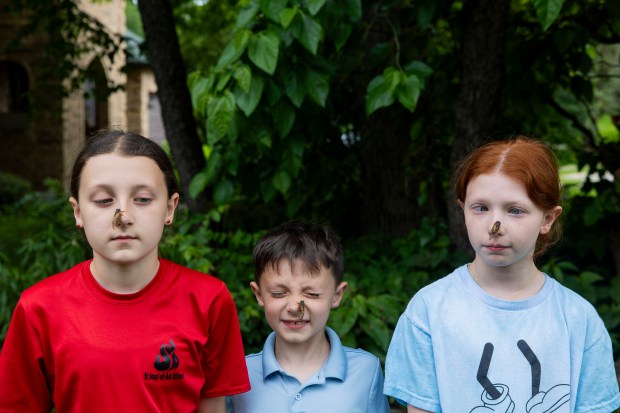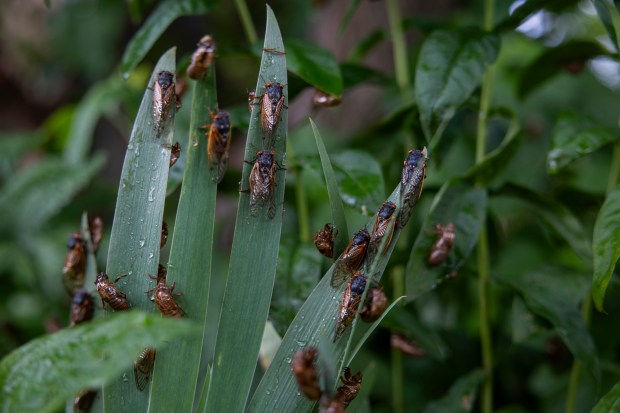Kris Rey was anticipating a cicada invasion. News story after news story seemed to promise a summer teeming with the insect.
But weeks in, Rey hasn’t seen a single cicada in Lincoln Square. She jokingly called the phenomenon, “the Great Cicada Scandal of 2024.” Or, she mused, “Y2Cicada.”
“It’s a lot of hype for a disastrous event that never happened at all,” Rey said with a laugh. “Y2K was the biggest example of that in my memory.”
And Rey isn’t alone. Sightings of periodical cicadas are few and far between in much of the city. But it’s a much different story for those in Far Southwest Side neighborhoods such as Beverly, as well as the suburbs where the insects’ sound is inescapable.
This year marks a rare double emergence, with the cycles of the 17-year and 13-year cicadas aligning for the first time in 221 years. The last overlap of Brood XIX, four species that appear every 13 years in the Southeast, and Brood XIII, three species that appear every 17 years in northern Illinois, was in 1803.
In Lisle, cicadas blanketed Tim Wangler’s front yard. His walkway was littered with shells, and nearly every leaf was crawling with the insect. He didn’t mind.
“It doesn’t bother me at all,” Wangler said. “It gives me that nostalgic feeling of summer. It reminds me of being a kid.”
The Tribune has photographed Wangler during the past two cicada emergencies in Illinois, beginning in 1990 when he was 8 years old. He now has three children of his own.
“We just have cicadas everywhere,” he said. “You can’t walk without stepping on them.”

Why aren’t there lots of cicadas in the city?
Cicadas are typically forest dwellers who like to eat the roots of trees, according to Kacie Athey, an assistant professor at the University of Illinois at Urbana-Champaign. It’s not that cicadas inherently can’t survive in the city — a 100-year-old tree could be a good home, for example — but development has made ideal conditions quite rare, she said.
“So much of cities have been changed or paved over — trees have been taken out, suburbs have been built, and those areas wouldn’t be places that the cicadas would be able to survive,” Athey said.
The bugs tend to congregate in areas with older trees and undisturbed soil, she said. They also really like places where there are vestiges of forests left. In Cook County, there’s a decent chance of spotting them at the forest preserves, she said.
But, if you haven’t seen cicadas at a specific location, you’re probably not going to, Athey said.
“The northern Illinois brood definitely comes out later than the great southern brood, just because of its temperature,” she said. “But by now, not to say there’s not still ones coming out of the ground, but any given location, if you haven’t started to see some activity, you’re probably not.”
To better understand the frequency of cicada sightings, Athey recommends checking out Cicada Safari, an app created by Gene Kritsky at Mount St. Joseph University in Cincinnati. Anyone can submit photographs of periodical cicadas to the app. Once an expert verifies the picture, it’s posted to a live map.
In the Chicago area, the app Friday afternoon showed thousands of confirmed sightings in the west and southwest suburbs, including Oak Park, Downers Grove and Palos Hills. Thousands more were in north suburbs, such as Highland Park and Glenview.
Glimpses of cicadas were more sparse within city limits, the app showed. While there were a couple hundred sightings in Beverly and (unsurprisingly) about 100 near the LaBagh Woods on the Northwest Side, many neighborhoods had no more than a dozen.

Ellen Houze, a 66-year-old Beverly resident, was working outside her home Friday afternoon, while cicadas loudly buzzed. Their sound can reach decibels comparable to a jet engine or lawn mower. She started hearing the buzzing about a week ago.
A retired teacher, Houze said she’s only seen one cicada in her yard, but in central Beverly, there are more. Some neighbors have protective netting wrapped around trees, she said.
“You get used to it. It’s not that bad, so it’s sort of fun,” Houze said of the sound. “I was here for the other one (emergence) that happened 17 years ago and it wasn’t a big deal.”
Yet on a recent sunny morning in the West Loop, a park was devoid of the insects. Trees and foliage dotted the landscape, and only the dull hum of city noise cut through the air. Chicagoans at the park said they hadn’t spotted a single cicada in the neighborhood.
Kevin Sievers watched his 2-year-old son climb on the playground. He wasn’t surprised that there weren’t cicadas in a densely populated, urban area.
“Every 17 years, they make a huge deal of it, but in the city, I just don’t think they ever come out,” Sievers said. “It’s just not their natural environment.”
He watched his son amble across the grass.
“He hasn’t seen a cicada, and he doesn’t know what it is,” Sievers said. “He probably won’t for a while.”




